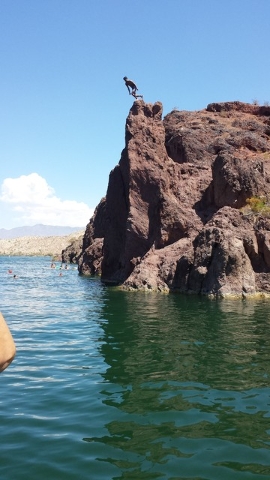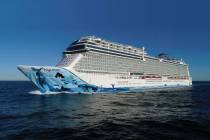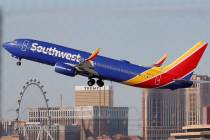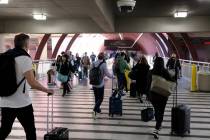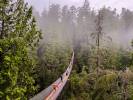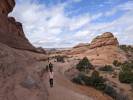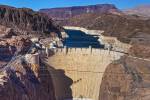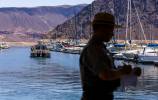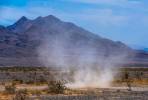Lake Havasu offers a bridge to the past
Lake Havasu City may be the ultimate mixed metaphor — the home of a 187-year-old English bridge transported to a 38-year-old city on the eastern edge of the Mojave desert, where water sports reign supreme and 21st-century spring breakers love to party.
It was not always thus.
This arid region in northwestern Arizona saw its first white settlers when trappers came along in the early 1800s. Skirmishes between settlers and natives and the Mexican-American War led to the establishment of Fort Yuma, across the Colorado River from present-day Yuma, Arizona, in 1848. Because of its remote location, the fort was used sporadically until 1852, when the “Uncle Sam” became the first of a flurry of paddle-wheel steamboats to begin regular runs. Their slight drafts were ideal for the shallow water, and their steam was powered by the Cocopah Indians, who operated lumber yards along the river. Because of the rugged terrain, overland transportation was problematic at best, and the boats supplied the fort, miners and river settlements and transported the miners’ ore to market. The steamboat era would end, however, with the 1908 construction of the Laguna Dam, which closed the river a few miles above Fort Yuma.
Lake Havasu was formed by the completion of the Parker Dam in 1938, and fishing camps were springing up to supplant the riverboats, although some of the camps were closed when the Army Air Forces decided this would be the perfect spot for an emergency air strip for the Kingman Army Air Field and a rest and rehabilitation camp for GIs fighting World War II. The Army abandoned its camp — dubbed Site 6 — after the war, but Lake Havasu’s heyday was yet to come.
Robert McCulloch, who had been a powerboat racer of national standing during the late ’20s and early ’30s, had inherited a share of his grandfather’s fortune and went on to make his own with McCulloch Engineering Co., which he sold in the ’30s for $1 million (the equivalent of more than $15 million today), and its successors, California-based McCulloch Motors Corp., which dominated the chain-saw market, and McCulloch Oil Corp. in Texas.
But McCulloch hadn’t officially abandoned boat engines, and found himself flying above Lake Havasu after the war in search of a site to test them. He initially bought 3,500 acres along the lakeshore, and in 1963 purchased 26 square miles of land in the region with the aim of developing a city. He even opened a chain-saw factory there in an effort to encourage development, but interest in his paradise remained as dry as the desert winds.
By 1964, McCulloch had purchased a fleet of 11 Lockheed Electras with the aim of bringing people in to buy property in his new town. Sales remained slow, though, and he needed something to attract attention. And then McCulloch had what may have been his biggest brainstorm. He learned that the City of London had decided to auction the solid-granite London Bridge, which was sinking into the Thames River, and replace it with a lighter bridge of hollow reinforced concrete. McCulloch figured out how much it would cost to dismantle the bridge and then doubled it to arrive at $2.4 million. He then added $60,000, which represented $1,000 for each of the 60 years of his life at that time. According to legend repeated by at least one Lake Havasu boat operator, the other bidder was entertainer Red Skelton, who bid $2.4 million, and it was only because of his $60,000 whim that McCulloch had his bridge.
But there may be a reason that buying a bridge is a metaphor for foolishness, because it would take three years and $7 million to move it. McCulloch hadn’t lost his resourcefulness, though. He, too, decided the bridge was too heavy, and had slabs sliced off the facing stones, which were numbered and shipped to be used to face a bridge of hollow reinforced concrete. While the tale may be apocryphal, McCulloch reportedly used only 20 percent of the original granite for the new bridge, selling the rest in Europe to recoup his expenses.
It took three more years to construct the new bridge, and after it was completed McCulloch had a mile-long channel dredged, turning the Pittsburgh Point peninsula into an island and creating the Bridgewater Channel, which provided a shortcut between the upper part of Lake Havasu and Thompson Bay to the south. The bridge was dedicated in 1971, with the Lord Mayor of London in attendance.
The upcycling of the bridge attracted the desired attention; McCulloch increased his fleet of Lockheeds and his city was on its way. The flights continued until 1978, when the city was incorporated a year after McCulloch’s death. In 2014, its population was estimated at more than 53,000.
But while the city has grown, the bridge and the lake remain the centerpiece — not surprising, considering that water temperatures range from 75 to 85 degrees during most of the year. The channel below the bridge now is lined with seawalls with rigging loops mounted every few feet, creating veritable boat parking lots with the craft floating just feet from each other while their passengers have fun in the water. Thanks to a 1995 MTV special, spring break is a prime time for visitors, with 15,000 to 20,000 college-age students congregating there each year. So are holidays; if you want a Labor Day spot in Bridgewater Channel it’s best to arrive by 5:30 a.m., and some 200 to 300 boats will congregate on holiday weekends in Copper Canyon south of the bridge, a prime party spot.
As you might imagine, the popularity of water sports — primarily motorized water sports — on Lake Havasu means that there is an abundance of places that offer boat tours or rent personal watercraft, boats of every description, stand-up paddleboards and toys like wakeboards and tubes. If you have your own boat there are plenty of places to launch it, and if you like to fish or hike, there are quite a few options. Off-road rentals, bike rentals, golf courses, disc golf, scuba diving, hot-air balloons and a skate park — the list of outdoor activities seems endless. There even are 24 lighthouses, almost all of them one-third-scale replicas of well-known American lighthouses, which serve as navigational beacons for boaters.
For the rest of us, the sounds of partying clearly mark the way.
Contact Heidi Knapp Rinella at Hrinella@reviewjournal.com. Find more of her stories at www.reviewjournal.com, and follow @HKRinella on Twitter.
Directions: Lake Havasu City is about 150 miles from Las Vegas, for a drive of about 2 1/2 hours. Take Highway 95 south for about 90 miles toward Needles, Calif., then pick up I-40 and travel east about 20 miles to Arizona Highway 95, then head south about 17 miles. There is no commercial air service into Lake Havasu City.
Details: For information on activities, lodging, dining, camping, special events, family activities and special deals, go to the web site of the Lake Havasu Convention & Visitors Bureau (whose motto is "play like you mean it") at www.golakehavasu.com, or call 800-242-8278.







